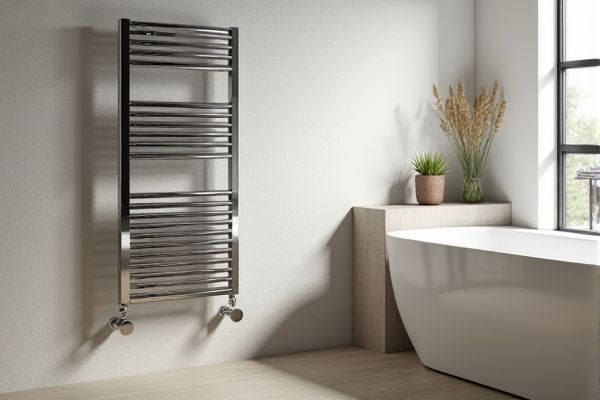
Heated towel rails offer the dual benefit of warming towels quickly while reducing moisture, preventing mildew and providing a spa-like comfort in your bathroom. Discover how choosing between a heated towel rail and a conventional towel rack can enhance Your daily routine by reading the rest of this article.
Table of Comparison
| Feature | Heated Towel Rail | Conventional Towel Rack |
|---|---|---|
| Heating Capability | Provides consistent heat to dry and warm towels | No heating functionality, only holds towels |
| Drying Speed | Dries towels quickly, reducing dampness and mildew | Dependent on air drying, slower and less effective |
| Energy Consumption | Consumes electricity or hot water (varies by model) | No energy consumption |
| Installation | Requires electrical wiring or plumbing installation | Simple wall mounting, easy installation |
| Cost | Higher initial and operating costs | Low cost and maintenance |
| Aesthetic Appeal | Modern, sleek designs available | Varied styles but generally traditional look |
| Space Efficiency | Often vertical, saves bathroom space | Varies, can take more wall space |
| Additional Benefits | Helps reduce bathroom humidity | No added benefits besides towel storage |
Introduction to Heated Towel Rails vs Conventional Towel Racks
Heated towel rails provide consistent warmth and faster drying times compared to conventional towel racks, which merely hold towels without heating. Your bathroom comfort improves with heated rails by reducing dampness and preventing mildew buildup on towels. Energy-efficient designs and modern aesthetics make heated towel rails a practical upgrade from traditional racks in both functionality and style.
How Heated Towel Rails Work
Heated towel rails use electrical elements or hot water pipes to warm the metal bars, effectively drying towels and providing consistent heat. Unlike conventional towel racks that rely solely on ambient air, heated rails maintain a warm temperature, reducing moisture and preventing dampness. Your bathroom benefits from quicker drying times and enhanced comfort with the efficient heat distribution of heated towel rails.
Design and Aesthetic Differences
Heated towel rails feature sleek, modern designs with tubular bars that provide a contemporary and elegant look, enhancing bathroom aesthetics while warming your towels. Conventional towel racks often have simpler, traditional designs made from wood or metal, focusing primarily on functionality rather than style. Choosing a heated towel rail not only elevates your bathroom decor but also adds a luxurious and cozy element to your daily routine.
Energy Efficiency Comparison
Heated towel rails consume between 60 to 150 watts, providing consistent warmth and drying benefits while using less energy than running a tumble dryer. Conventional towel racks use no electricity but rely on ambient room heat, leading to slower drying times and potential dampness, which may increase energy costs for heating the bathroom. Choosing a heated towel rail with an energy-efficient thermostat and timer offers better energy control compared to the passive nature of conventional racks.
Heating Performance and Comfort
Heated towel rails provide superior heating performance by evenly warming towels and the bathroom space, enhancing comfort and reducing dampness. Conventional towel racks lack active heat, resulting in slower drying times and less cozy towels. Investing in a heated towel rail ensures your towels are warm and ready, significantly improving your daily comfort.
Installation and Maintenance Requirements
Heated towel rails require electrical or plumbing connections, making installation more complex and potentially costly compared to the simple wall mounting of conventional towel racks. Maintenance for heated rails involves periodic checks for electrical safety and possible descaling in water-based systems, whereas traditional racks need minimal upkeep. Your choice depends on balancing convenience with installation effort and ongoing care.
Cost Considerations: Upfront and Long-Term
Heated towel rails typically involve higher upfront costs due to electrical installation and the unit price, but they offer energy-efficient warmth that can reduce long-term heating expenses. Conventional towel racks are less expensive initially, requiring no power source, but they lack heat functionality, which may lead to damp towels and increased laundry frequency. Your choice should balance initial budget constraints with ongoing energy savings and comfort benefits.
Space-Saving and Versatility Features
Heated towel rails offer significant space-saving advantages by combining drying and warming functions in a sleek, vertical design that fits compact areas better than bulky conventional towel racks. Their versatile temperature control ensures towels dry quickly, reducing moisture and mildew risks, while some models double as supplementary room heaters, enhancing functionality without requiring extra space. Your bathroom benefits from a modern, efficient solution that optimizes both storage and comfort.
Health and Hygiene Benefits
Heated towel rails reduce moisture, preventing the growth of mold, mildew, and bacteria that commonly develop on damp towels, promoting a healthier bathroom environment. Conventional towel racks allow towels to air-dry slowly, which can lead to unpleasant odors and increased microbial presence. Your choice of a heated towel rail supports better hygiene by ensuring towels dry quickly and remain fresh for each use.
Making the Right Choice for Your Bathroom
Heated towel rails provide consistent warmth and faster drying times compared to conventional towel racks, reducing dampness and mildew buildup in your bathroom. While conventional towel racks rely on ambient heat and airflow, heated rails elevate comfort and hygiene by keeping towels warm and dry. Choosing a heated towel rail enhances your bathroom's functionality and luxury, making it a smart investment for long-term wellness.
 homyna.com
homyna.com